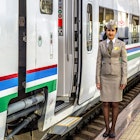
Jan 8, 2025 • 11 min read

The Trans-Siberian train near Lake Baikal © Serjio74 / Shutterstock
Watching thousands of miles of snow-kissed forests fly past your window, alighting in remote cities across Russia – it’s no wonder that travellers are captivated by the Trans-Siberian Railway. Embarking on a train journey from Moscow to Vladivostok or Beijing requires good planning and a sense of adventure, and packing the right gear can make or break a trip. Here’s a handy guide to help you get started.

First things first: for all the romantic images associated with the Trans-Siberian Railway, it’s not a spontaneous hop-on/hop-off affair. You’ll need to decide your route, secure relevant visas, and buy tickets for each leg of the journey (either in situ or from your home country through an agency). The route from Moscow to Vladivostok requires only a Russian visa (apply at least one month in advance). Some nationalities will need a Mongolian visa for travel, and if you’re starting or finishing in Beijing you’ll almost certainly need a Chinese visa.
Unless you’re planning a non-stop journey, reserve accommodation anywhere you’re stopping along the way. In summer, popular Lake Baikal guesthouses may book up; in winter, some hotels shut down – either way, plan ahead.
Finally, get your head around the Cyrillic alphabet and Russia’s multiple time zones. Even if you don’t graduate to conversational Russian, the alphabet is essential to decipher train departure boards. Russian train tickets list your departure following Moscow time (even if you’re five hours ahead in Ulan-Ude). Consider setting up a couple of clocks on the home screen of your phone or tablet, referencing a couple of time zones you’ll be crossing.
If you’re able to carry gear on your back, a rucksack keeps your hands free to flash tickets and passport. Duffel bags and rucksacks are best for squashing into on-board luggage storage. If you must go with a roller suitcase, choose a slender, lightweight case – train corridors are narrow. There's little elbow room aboard the train to dig through your luggage, so organise essentials into a small rucksack for easy access: include your toothbrush, wet wipes (you'll need them), snacks and the paperwork for your trip.
It's a good idea to pack a ‘train uniform’: light, comfortable clothing you can snooze in, but not so scruffy you’ll attract gasps in the dining carriage. Whatever the season, Trans-Siberian train carriages are often kept toasty warm – sometimes stiflingly so. Loose cotton slacks and a T-shirt are ideal, plus a light sweater or hoodie. And don’t forget flip-flops or slippers to wear aboard. Trust us, there’s nothing like stepping on the floor of a well-frequented 3rd-class toilet stall to make you want to burn your socks.

Outside the train, think layers. Alongside a selection of T-shirts, jeans and undies bring a woollen base layer and thick socks – even in summer, the evenings can get chilly. Summer travellers stopping by Lake Baikal won’t want to forget insect repellent and a head net for lakeside hikes.
Be thoughtful when selecting your footwear. Comfortable, broken-in hiking boots will see you from city sightseeing to outdoor exploring. Resist the urge to weigh down your luggage with flashy shoes and your best threads. Outside Moscow there is less ‘face control’ (where door-staff admit or reject people based on their attire) and more casual bars that won’t balk at backpackers in jeans.
For a journey in winter, add a fleece, down-lined coat and/or ski jacket, leggings to layer under your jeans or even padded trousers (the kind suitable for winter sports). The winter chill is felt most painfully in your extremities, so don’t forget a hat and quality gloves. You might want to invest in ski gloves, designed to protect your digits down to -30C.
Keen photographers should consider buying ski gloves and separate merino glove liners. Wearing just the liners gives you enough dexterity to wield a camera and protects your hands for a few precious seconds while you point your lens at a snow-dusted cathedral.

The fountain of sustenance aboard your Trans-Siberian train is the samovar, a tureen brimming with hot drinkable water. With nowhere on the train to refrigerate food, pack snacks that only need hot water for preparation: pots of instant noodles, sachets of oatmeal and soup, and a treasure chest of tea bags and coffee. Anything perishable you’ll have to eat within the first few hours of your journey, before your cheese and yoghurt start sweating in the warm air.
Bring your own drinking vessel, ideally a reusable insulated cup with a fitted lid. You can borrow or buy mugs on board but they don’t have lids, which means a delicate samba back through the jolting train compartment as you attempt not to scald yourself.
Don’t try to cram your rucksack with food for the entire trip. There’s plenty of opportunity to restock at stops along the way, even if you’re travelling Moscow–Beijing in a single journey. Before disembarking, double-check the timetable (usually pasted by the carriage door) or ask your provodnitsa (carriage attendant) how long the train is pausing – watching your train rumble away is a heavy price to pay for instant noodles.
Vendors ply the station platforms with snacks (although there are fewer in winter) and shops inside train stations offer fresh food, dumplings, and samovar-friendly instant snacks. The usual street food rules apply: follow local norms (queues for cooked food are a good sign), choose peelable fruit, and beware unrefrigerated dairy.
Snack trolleys on board can tide you over (although they’re comparatively expensive) and when you buy some train tickets, it's possible to package in meals, which are brought to your compartment. The quality varies and you’ll enjoy much more choice if you bring cash for a couple of meals in the dining carriage.

Travel apps can make on-board life even more rewarding. Download them before you go – there’s no on-board wi-fi. Google Translate has an offline translation function, just download the necessary languages. This is immensely useful when asking carriage attendants questions, ordering in the restaurant car, or making small-talk with fellow travellers. If time zones scramble your brain, keep track with an app like Time Zone Converter; add your main stops for an at-a-glance guide. While some travellers bring a headlamp – especially useful in 3rd class at night – others use their phone’s in-built torch function or an app like Flashlight.
Download books to an e-reader or phone app before you travel, too. Good intentions to read War and Peace can get eroded by bleary-eyed 3am passport checks, so bring along your guiltiest literary pleasures: true crime, erotic sci-fi, there’s no judgement on a long-haul train. If you prefer not to stare at a screen, consider hostel book swaps along the way, to avoid hauling heavy paperbacks across the tundra.

Feeling the strain of 15 hours spent staring at birch forests? These lightweight items will make your trip all the merrier.
Sleep kit Even if you aren’t a light sleeper, bring earplugs and eyeshades to guard against the bright beams of oncoming trains and snoring bunkmates.
Headphones Fellow passengers may be generous enough to share their taste in frenetic Russian pop music. Quality headphones can block it out where earplugs fail.
Knife and spork An all-purpose spork, ideally heatproof, will help you shovel down soups, slurp noodles and stir up drinks from the samovar. A small penknife is handy if you're making multiple stops and envisaging a lot of picnics.
Spare toilet roll You may not need it, but you’ll never regret squashing this into a corner of your rucksack.
Portable battery First-class compartments have sockets (and they usually work), but in 2nd class and lower you may be competing with someone for use of the very few charging points in your carriage. Consider bringing a portable battery pack and don't forget a universal plug adapter.
Tipples to share Yes the stories about sharing vodka with your bunk mates are true, and bringing a bottle is an easy way to make friends. If you don't drink alcohol, fruit tea bags are happily received, too.
Notepad Even if you don’t rate the quality of your scribbles, bring a notebook and pen. It’s a handy way to communicate with train staff or other travellers by doodling or jotting down numbers. And as miles of taiga unfurl, with lake-shore villages and turquoise-painted houses rushing past your window, thoughts may bloom in your mind that you’ll want to capture forever.
Female Solo Travel: taking the Trans-Siberian railway alone
Beyond the Trans-Siberian: travelling Russia's unexplored northwest by train
Russia for first-timers: dos and don’ts
The Siberian welcome: the best guides along the world’s longest train journey
Article first published in April 2015, and last updated by Anita Isalska in December 2019


Jan 8, 2025 • 11 min read


Jul 18, 2023 • 5 min read



Oct 27, 2021 • 7 min read


Aug 19, 2020 • 5 min read
